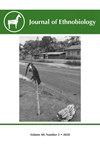诺兰指数:列表相似性的定量测量
IF 1.3
3区 社会学
Q1 ANTHROPOLOGY
引用次数: 0
摘要
一些民族生物学研究使用了雅卡德指数(Jaccard Index),这是一种定性的二元测量方法,用来比较植物和动物物种、药物、食品、文化公用事业等方面的群体相似性和差异性。我们通过制定诺兰指数(Nolan Index)来扩展这一努力。诺兰指数是一种新的、更精确的量化指标,用于衡量列出项目的相对频率,以比较不同群体之间的相似性和差异性。在这里,它被用来评估密苏里州农村地区的新手和专家之间自由上市的野生植物的相似程度。本文章由计算机程序翻译,如有差异,请以英文原文为准。
The Nolan Index: A Quantitative Measure of List Similarities
Several ethnobiological studies have used the Jaccard Index, a qualitative, binary measure, to compare group similarities and differences in lists of plant and animal species, medicinals, foods, cultural utilities, and so on. We extend this effort by formulating the Nolan Index, a new, more precise quantitative measure of the relative frequency of listed items to compare similarities and differences between groups . It is deployed here to evaluate the degree of similarity of free-listed, wild plants between novices and experts in rural Missouri.
求助全文
通过发布文献求助,成功后即可免费获取论文全文。
去求助
来源期刊

Journal of Ethnobiology
Social Sciences-Anthropology
CiteScore
4.80
自引率
3.40%
发文量
21
审稿时长
>12 weeks
期刊介绍:
JoE’s readership is as wide and diverse as ethnobiology itself, with readers spanning from both the natural and social sciences. Not surprisingly, a glance at the papers published in the Journal reveals the depth and breadth of topics, extending from studies in archaeology and the origins of agriculture, to folk classification systems, to food composition, plants, birds, mammals, fungi and everything in between.
Research areas published in JoE include but are not limited to neo- and paleo-ethnobiology, zooarchaeology, ethnobotany, ethnozoology, ethnopharmacology, ethnoecology, linguistic ethnobiology, human paleoecology, and many other related fields of study within anthropology and biology, such as taxonomy, conservation biology, ethnography, political ecology, and cognitive and cultural anthropology.
JoE does not limit itself to a single perspective, approach or discipline, but seeks to represent the full spectrum and wide diversity of the field of ethnobiology, including cognitive, symbolic, linguistic, ecological, and economic aspects of human interactions with our living world. Articles that significantly advance ethnobiological theory and/or methodology are particularly welcome, as well as studies bridging across disciplines and knowledge systems. JoE does not publish uncontextualized data such as species lists; appropriate submissions must elaborate on the ethnobiological context of findings.
 求助内容:
求助内容: 应助结果提醒方式:
应助结果提醒方式:


